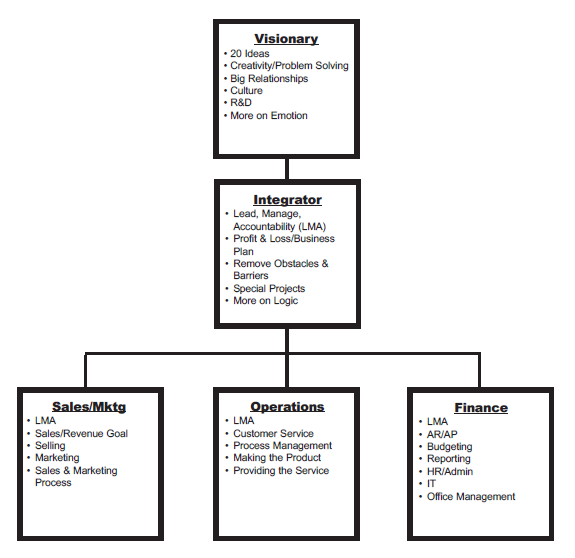 Those familiar with EOS know that an Accountability Chart crystallizes roles and responsibilities for everyone in the organization. It’s built by focusing first on the right structure for the organization – identifying the major functions (seats) necessary to execute on the company’s vision over the next 6-12 months and then carefully defining the five roles the owner of each seat must obsess about every day to be successful. Only then can you focus on getting the right people in the right seats. It’s a simple tool that clearly defines the things for which every single person in the organization is accountable.
Those familiar with EOS know that an Accountability Chart crystallizes roles and responsibilities for everyone in the organization. It’s built by focusing first on the right structure for the organization – identifying the major functions (seats) necessary to execute on the company’s vision over the next 6-12 months and then carefully defining the five roles the owner of each seat must obsess about every day to be successful. Only then can you focus on getting the right people in the right seats. It’s a simple tool that clearly defines the things for which every single person in the organization is accountable.
Last week, after nearly 500 full-day sessions with the leadership teams of more than 65 entrepreneurial companies, something hit me for the first time. I’ve become quite familiar with the power of defining someone’s accountability clearly, with just a handful of words. I’ve seen dozens of teams, hundreds of leaders and thousands of employees use this simple tool to get more of the right stuff done because they’d replaced assumptions, murkiness, and complexity with clarity and simplicity. But I’d always been focused on the importance of defining the things for which people ARE accountable. Last week it dawned on me that the real value of an Accountability Chart might be defining the things for which people are NOT accountable.
I’m convinced that most people in entrepreneurial companies spend way too much time on stuff they shouldn’t be doing. It’s the salesperson who keeps meddling with operations (because I need to be able to count on them to serve my clients). I’m talking about the Visionary that wants to run the day-to-day or the Integrator that won’t let his key leaders run their departments. I’m talking about people attending meetings without contributing, people “pitching in” on a project that’s under control and losing focus on their own priorities, and even the folks that waste time kibitzing at the water-cooler. This behavior – doing work that you aren’t being asked to do and isn’t the best way for you to contribute value to the organization – can kill a small company.
So what I realized last week and resolved to become more passionate about in my own business and when working with my clients is this: You can’t obsess about the five roles in your seat when you’re busy obsessing about five other things. So stop doing it. If it’s important to the company and not clear who wins it, make it clear by adding it to the right seat on your Accountability Chart. If it’s a role owned by someone else in the company, let them own it (with accountability for great results). And if it’s not important to the company, stop doing it.



